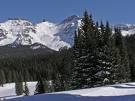Pino Real Tree Information
Images of Pino Real:






Pino Real grows in the following 14 states and provinces:
Alberta, Arizona, British Columbia, California, Colorado, Hawaii, Idaho, Montana, Nevada, New Mexico, Oregon, Utah, Washington, WyomingInformation about Pino Real:
The Picea Engelmannii is commonly known as the Columbian Spruce, Engelmann Spruce, Mountain Spruce, Pino Real, Silver Spruce as well as White Spruce.
The genus Picea consists of about 30 species of evergreen trees found in cool, temperate regions of the northern hemisphere. Seven species of Picea, including Engelmann spruce, are native to North America. The currently accepted scientific name of Engelmann spruce is Picea engelmannii Parry ex Engelm. . There are no recognized races or geographic varieties. Natural hybridization between species of Picea is common. Engelmann spruce x white spruce (Picea glauca) hybrids are common where the ranges of these species overlap. Natural crosses between these species occur from central British Columbia as far south as eastern Washington and Yellowstone National Park . Within this area, trees at low elevations closely resemble pure white spruce. Pure Engelmann spruce tends to dominate at higher elevations . Engelmann spruce x white spruce hybrids are common throughout low elevations in British Columbia . Using artificial pollination techniques, Engelmann spruce has been successfully crossed with white spruce, blue spruce (P. pungens), and Sitka spruce (P. sitchensis) .Engelmann spruce is widely distributed throughout the mountains of the western United States and Canada. It occurs from central British Columbia and Alberta as far south as New Mexico and Arizona . It is cultivated in Hawaii . In the Pacific Coast region, Engelmann spruce is only a minor component of high-elevation forests. It grows from the Coastal Range in west-central British Columbia, south along the east slope of the Cascades through Washington and Oregon to Mount Shasta in northern California . In the Rocky Mountains Engelmann spruce is a major component of high-elevation forests. It grows from southwestern Alberta, south through the mountains of eastern Washington, Idaho, and western Montana to the high mountains of southern Arizona and New Mexico .Climax stands consisting entirely of Engelmann spruce are somewhat scattered and often restricted to wet or cold habitats . The Engelmann spruce series is generally recognized by the absence or scant representation of subalpine fir. This is because many ecologists, especially those working in the northern Rocky Mountains, believe that only in the absence of subalpine fir does Engelmann spruce dominate at climax . Throughout the Rocky Mountains, Engelmann spruce occurs in widespread forests within the subalpine fir or white fir (Abies concolor) habitat-type series either as a climax codominant or long-lived seral species . In the northern Rocky Mountains, Engelmann spruce is considered a long-lived seral species in fir habitat types. In the central and southern Rocky Mountains, Engelmann spruce and subalpine fir often codominate at climax; however, these forests are classified under the subalpine fir series to be consistent with habitat-type usage elsewhere . Published classification schemes listing Engelmann spruce as an indicator or dominant in habitat types (hts), community types (cts), plant associations (pas), ecosystem associations (eas), site types (sts), riparian zone associations (rzas), or dominance types (dts) are presented below: Area Classification Authority AZ, NM: ----- forest & woodland hts Layser & Schubert 1979 ----- forest hts Moir & Ludwig 1979 Apache, Gila, Cibola NFs forest hts Fitzhugh & others 1987 s of Mogollon n AZ: San Fransisco general veg. cts, hts Rominger & Paulik 1983 n AZ, n NM forest hts Larson & Moir 1987 CO: Arapaho & Roosevelt NFs forest hts Hess & Alexander 1986 Gunnison & Uncompahgre NFs forest hts Komarkova & others 1988 Routt NF forest hts Hoffman & Alexander 1980 White River NF forest hts Hoffman & Alexander 1983 w CO riparian pas Baker 1989a ID: Sawtooth, White Cloud, Boulder, & Pioneer Mtns general veg. cts Schlatterer 1972 c ID forest hts Steele & others 1981 n ID forest hts Cooper & others 1987 e ID, w WY forest hts Steele & others 1983 riparian cts Youngblood & others 1985a MT forest hts Pfister & others 1977 riparian dts Hansen & others 1988 c, e MT riparian cts, hts Hansen & others 1990 nw MT riparian hts, cts Boggs & others 1990 sw MT riparian sts, cts, hts Hansen & others 1989 NM: Cibola NF forest hts Alexander & others 1987 Lincoln NF forest hts Alexander & others 1984 n NM, s CO forest hts Develice & others 1986 OR: Wallowa-Whitman NF steppe & forest pas Johnson & Simon 1987 Deschutes, Ochoco, Fremont & Winema NF's riparian rzas Kovalchik 1987 OR, WA: Blue Mtns forest & nonforest cts Hall 1973 c, s UT forest hts Youngblood & Mauk 1985 n UT forest hts Mauk & Henderson 1984 UT, se ID riparian cts Padgett & others 1989 WA: Okanogan NF forest pas Williams & Lillybridge 1983 WY: ----- riparian cts Olson & Gerhart 1982 Medicine Bow NF forest hts Alexander & others 1986 Bighorn Mtns forest hts Hoffman & Alexander 1976 Wind River Mtns forest hts Reed 1976 USFS R-4 aspen cts Mueggler 1988 AB general veg. cts Moss 1955 w-c AB forest cts Corns 1983 general veg. eas Corns & Annas 1986 BC: Prince Rupert Forest Region general veg. eas Pojar & others 1984Some of the information provided here is attributed to:Uchytil, Ronald J. 1991. Picea engelmannii. In: Fire Effects Information System, [Online]. U.S. Department of Agriculture, Forest Service, Rocky Mountain Research Station, Fire Sciences Laboratory (Producer). , available at the USDA Fire Effects Information System (FEIS) website